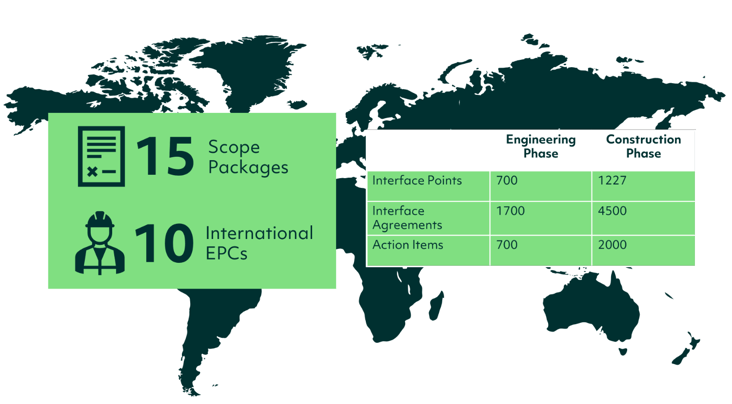
10 Best Practices of Interface Management
During my career, I’ve helped implement interface management on numerous projects, and some of them have been the largest projects in the world. With each of these projects, I’ve worked with some exceptional teams and witnessed incredible feats of progress, but one project has always stood out as one of the best implementations and executions of interface management I’ve ever seen. Not only did this project excel at interface management execution, but it may also have been one of the company’s most successful projects. The project met all the company’s goals and, even though it encountered many major hurdles along the way, interface management helped the project stay on track and deliver on schedule. Which is almost unheard of on major projects!
Much of the success of the interface management program can be attributed to the interface manager who developed the 10 best practices of interface management we are sharing in this article.
The Project
The project consisted of 15 scope packages to be executed by 10 international EPCs. The company estimated that over 3000 engineering deliverables would be exchanged between contractors during the engineering phase. Adding to this complexity was the fact that many scopes of work would be out of phase, moving through engineering gates at different times on different schedules.

At the time, third-party interface had been identified as one of the project’s top 10 risks. The project represented a multibillion-dollar capital investment and would be executed in a very remote northern region of Canada over 6 years. The owner-operator knew they needed to invest in enhancing their interface management practices. They started down the road of this process improvement.
Using lessons learned from previous projects and industry consultants, an interface management plan was developed for the project and has since been adopted as the corporate engineering management standard. With an international execution strategy, they knew they needed an interface management software solution that could support a central source of information with accessibility for their globally distributed teams. A robust solution was required that would not only formally align their interfacing parties, but also provide early identification of issues with potential impact on cost or schedule and provide standardization across projects aligning with the recently developed interface management plan.
The Team
Much of the project’s success can be directly attributed to the efforts of a dedicated interface manager. The interface manager promoted a high-performing environment with robust governance, healthy stewardship, and strong leadership. The importance of teamwork, shared values, principles, and goals were stressed, which was key to breaking down the silos that may have had an impact on project delivery. Everyone was working towards the overall goals of the project instead of individual goals. All interface teams had clear accountability, and this greatly reduced duplication of work. This cultural shift broke down communication barriers, which included not only external teams but internal as well.

The client interface team was very proactive. Enhancements were made to the interface management processes as the project progressed and they learned as a team. Quarterly surveys and global interface meetings were used to obtain feedback. The client interface team listened and acted on the feedback they received. Issues were discussed and barriers were eliminated. The interface team excelled at defining and adhering to key performance indicators (KPIs) – even meeting attendance, which required representation on the client side, was a KPI! Interface deliverables were integrated into the schedule using key interface milestones (KIMS) and the team integrated interface points into the 3D model.
The Best Practices of Interface Management
The following best practices were used and featured prominently throughout the interface management master and project execution plans. The purpose was to help team members make decisions and act in ways that benefited all teams, and the work to be performed. Five best practices specific to client representatives and five best practices specific to the external delivery teams were developed.
10 Best Practices of Interface Management
Client
- All interfaces need to have applicable client stakeholders involved.
Ongoing alignment and involvement by client stakeholders were essential. Client stakeholder attendance at meetings was mandatory which ensured their firsthand knowledge of changes and challenges on the project and their ability to provide consultation and solutions to mitigate risks ahead of time. - EPC/Contractors should not be expected, or put in a position, to provide facilitation and resolution of interface issues between other EPC/Contractor organizations.
If an interface dispute emerged, the project did not leave the decision to the external contractors. Escalation procedures were in place and used - Client stakeholders are responsible for their interfaces and need to understand their scope of work, the limits of their scope of work, and the interface processes.
The importance of client stakeholder involvement was continually enforced; contractors were not left on an island and expected to perform. - Client stakeholders need to have a working relationship with their client counterparts at all interfaces.
Priority should always be given to the benefit of the project, even if it’s at the cost of deficit to the individual project areas. - Client stakeholders need to have a working relationship with their client counterparts at all interfaces.
Teamwork! The project did a fantastic job of promoting teamwork and inclusion, eliminating, and breaking down the silos.
EP/EPC/Contractor
- Interface Manager appointed 30 days post kickoff.
External parties had to designate a single point of contact, and this had to be done within 30 days of onboarding. - First Issue of Area Specific Interface Management Plan 60 days post kickoff.
Working with their client representative, each EPC had to produce a scope-specific interface management plan aligning with the overall project interface management plan. - Interface Meetings 60 days post kickoff.
Interface meetings were arranged with all interfacing parties. - First issue of Interdependency Schedule 60 days post kickoff.
For every interface in which they were involved, contractors had to identify dates for the receipt of information and construction support required from other parties to complete their work. This was referred to as the interdependency schedule and was key in defining interface agreements and schedule dates. - Finalized Interface Points and Agreements 60 days post kickoff.
Contractors had 60 days to validate the interface register and interface agreements had to be raised early on. Teams were encouraged to treat interface management as the ‘selfish discipline’; to document and record what they needed from others as soon as possible. This gives all parties a clear understanding of what is expected from them, identifies workloads, and ensures potential issues are identified early on.
The Results
The project was a huge success with the process improvement (and the best practices that helped drive the interface management process) playing a significant role in the success of two of the five strategic corporate priorities by simplifying a key business process and delivering high returns from the project.
Overall, the interface manager and the supporting team played a crucial role in contributing to the success of this project. By creating an environment that fostered high performance and collaboration, plus a clear set of best practices that helped guide their interface management program, the project was able to leverage the collective skills and knowledge of the team.
This company started their project by assessing and addressing major risks to the project. This assessment led to the requirement for a robust interface management program. They put the time and effort into defining their practices and in the selection of an automated solution, which paid off with the huge success of the project.
To learn more about how interface management helped this project overcome major hurdles and finish on time, read our case study on this project: Interface Management Case Study: Delayed Project Finishes On Schedule.






